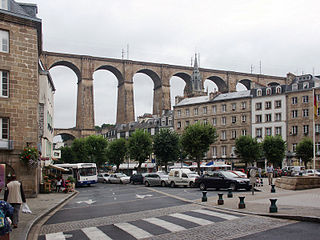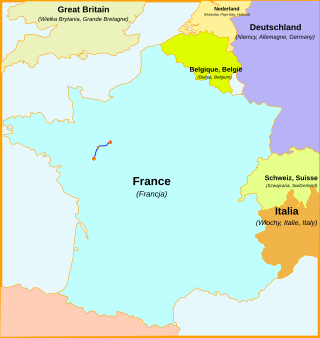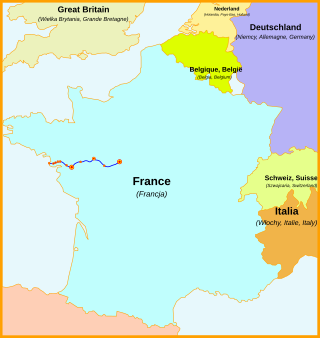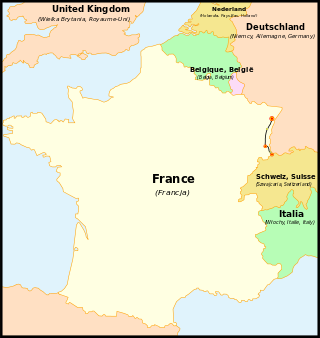
The railway from Mantes-la-Jolie to Cherbourg is an important French 228-kilometre long railway line, that connects Mantes-la-Jolie, a western suburb of Paris, with the northwestern port city Cherbourg via Caen. At Mantes-la-Jolie, the railway line is connected with the Paris–Le Havre railway. The line was opened between 1855 and 1858 by the Chemins de Fer de l'Ouest.

The railway from Paris to Brest is a 622-kilometre long railway line in France that connects Paris and the western port city Brest, via Le Mans and Rennes. It is used for passenger and freight traffic.

The railway from Paris to Bordeaux is an important French 584-kilometre long railway line, that connects Paris to the southwestern port city Bordeaux via Orléans and Tours. The railway was opened in several stages between 1840 and 1853, when the section from Poitiers to Angoulême was finished. The opening of the LGV Atlantique high speed line from Paris to Tours in 1989 has decreased the importance of this section of the line for passenger traffic; the opening of the LGV Sud Europe Atlantique in 2017 has seen all long distance passenger trains migrating to that line and leaving space for more regional and local trains, as well as freight trains.

The railway from Savenay to Landerneau is an important French 245-kilometre long railway line. It is used for passenger and freight traffic. The railway was opened in several stages between 1862 and 1867.

The railway from Paris-Est to Strasbourg-Ville is a 493-kilometre-long railway line that connects Paris to Strasbourg via Châlons-en-Champagne and Nancy, France. Officially, the line does not start at the Gare de l'Est in Paris: the first 9 km until Noisy-le-Sec is shared with the railway from Paris to Mulhouse. The railway was opened in several stages between 1849 and 1852. The opening of the LGV Est high speed line from Paris to Baudrecourt in Lorraine in 2007 has decreased the importance of the section Paris–Sarrebourg for passenger traffic.

The railway from Paris-Est to Mulhouse-Ville is a 491-kilometre long railway line, that connects Paris to Mulhouse via Troyes, Chaumont and Belfort, France. The railway was opened in several stages between 1848 and 1858.

The railway from Le Mans to Angers is an important French 132-kilometre long railway line. It is used for passenger and freight traffic. The railway was opened in 2 stages in 1863.

The railway from Tours to Saint-Nazaire is an important French 282-kilometre long railway line, following the lower course of the river Loire. It is used for passenger and freight traffic. The railway was opened in several stages between 1848 and 1857.

The Lison–Lamballe railway is an important 205.7-kilometre long railway line that runs between the French commune of Lison and the town of Lamballe. It is used for passenger and freight traffic. The railway was opened in several stages between 1860 and 1879.
The railway from Toulouse to Bayonne is an important French 319-kilometre long railway line, that connects the southern city Toulouse to the southwestern town Bayonne, running along the foothills of the Pyrenees. The railway was opened in several stages between 1861 and 1867.

The railway from Bordeaux to Sète is an important French 476-kilometre long railway line, that connects the southwestern port city Bordeaux to the southern port Sète via Toulouse and Narbonne. The railway was opened in several stages between 1855 and 1858.
The railway from Creil to Jeumont is an important French 187-kilometre long railway line, that connects Creil, a northern suburb of Paris, to Jeumont on the Belgian border. It was opened in several stages between 1847 and 1855. The opening of the LGV Nord high speed line from Paris to Lille in 1993 has decreased its importance for passenger traffic.

The railway from Strasbourg to Basel is a French and Swiss 141.3-kilometre long railway line. It is used for passenger and freight traffic. The railway was opened in 1840–1844. It was the first railway line to serve Switzerland.

The Marseille–Ventimiglia railway is a French-Monégasque-Italian 259-kilometre-long (161 mi) railway line. It opened in several stages between 1858 and 1872.

The railway from Orléans to Montauban is an important French 544-kilometre long railway line, that connects Orléans and northern France to Montauban and southern France via Limoges. The railway was opened in several stages between 1847 and 1893, when the section from Limoges to Brive-la-Gaillarde was finished.

The railway from Moret-Veneux-les-Sablons to Lyon is a French 492-kilometre long railway line, that connects the Paris region to the city Lyon via Nevers and Saint-Étienne. The railway was opened in several stages between 1828 and 1861. The section between Saint-Étienne and Saint-Just-sur-Loire was the first railway line in France. It has functioned as an alternative line for the Paris–Marseille railway between Paris and Lyon. Its main use, besides local traffic, is now for the connection between Paris and Clermont-Ferrand.

The railway from Rémilly to Saarbrücken is a French and German 55-kilometre long railway line, that connects the French Grand Est region to the German city Saarbrücken. The railway was opened between 1851 and 1852. It is part of the international railway connection between Paris and Frankfurt am Main.

The railway from Bordeaux to Irun is an important French 235-kilometre long railway line, that connects the southwestern city Bordeaux to northern Spain. The railway was opened in several stages between 1841 and 1864.

The railway from Amiens to Rouen is a French 114-kilometre long railway line, that connects Amiens to Rouen. It was opened in 1867. The line was electrified on 27 August 1984 at 25 kW 50 Hz, and was equipped with the restrained permissivity automatic blocking system, which since the 1990s has offered increasingly unsatisfactory operating conditions with respect to the increasing mixed passenger and goods traffic on the line.

The Metz–Luxembourg railway is a 72-kilometre-long (45 mi) French/Luxembourgish railway line, that connects the French Lorraine region to Luxembourg. The railway was opened between 1854 and 1859. It is an important international railway connection. The part in Luxembourg is designated as CFL Line 90.


















